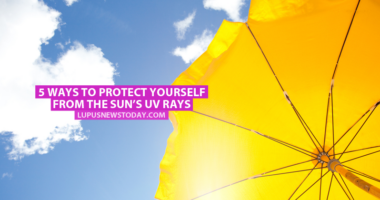3 tips for facing a change of seasons with lupus
How I protect against the additional heat and light of spring

Ah, the changing seasons. Spring is finally here, and for many people, it’s an exciting time of rejuvenation, of shedding winter coats and embracing the sun’s warmth. But for those of us with chronic illnesses like lupus, each seasonal change can feel like stepping into a battlefield of unpredictable triggers and symptoms.
For me, spring and summer are my two most dreaded seasons. Like clockwork each year, the combination of the blazing sun and the stifling heat cause a flare-up that lasts three to four months. Add in the rebirth of every pollen-producing plant and tree, and it’s a smorgasbord of fun all around!
While I have met a few people with lupus who can enjoy the sun and heat with no backlash, these seem to be two main triggers for most of my lupus brothers and sisters. For many of us, it can feel like that blazing ball of fire in the sky has a personal vendetta against our skin. And while those around me bask in its golden glow, I must seek refuge under layers of sunblock, protective long-sleeved clothing, hats big enough to provide ample shade, and close parking spots that allow me to run into the nearest store as quickly as possible.
If this sounds like you, I want you to know you’re not alone. In fact, the sun and heat lessen my quality of life so severely that my husband and I moved our entire life from Fort Lauderdale, Florida, to northern New York, near the Canadian border. Ten years in frigid temperatures and snow actually calmed my lupus symptoms down to a level I didn’t think was possible.
Don’t get me wrong, I love looking outside and seeing a sunny, beautiful spring day, but just five minutes under the sun’s rays causes me fevers, mouth and nose sores, the butterfly rash, and, in some cases, a full flare, all within 24 hours of exposure. Because of this, I will take 10-degree temperatures and snow any day of the week.
While many of us may be aware that the sun is a trigger we need to watch out for, it’s not going anywhere, and we still need to live our lives. The following are some tips that worked for me:
1. Look for clothing with UV protection
This type of clothing has a higher UPF, or ultraviolet protection factor, than most regular clothing, offering additional protection from the sun. The Skin Cancer Foundation recommends garments with a UPF of at least 30. Coolibar is one of my favorite UPF clothing brands because it offers colorful, fun options in a variety of sizes.
2. Prioritize self-care when it comes to invites
Spring and summer are the time of barbecues and weddings, beach days and vacations. Sure, we want to go to every event, but if we know sun and heat can take us down for days or weeks, we need to be intentional and selective with our attendance. If you can’t physically handle an event, suggest an alternative indoor activity like a movie night, board game marathon, or cozy dinner party. And if nighttime is your jam, why not propose evening outings like stargazing, nighttime beach volleyball, or moonlit walks?
3. Take notes during different seasons
I won’t go into my regular lecture about how we should all be journaling to track our symptoms; however, I will say that if you’re newer to a lupus diagnosis and aren’t yet sure how temperatures and sunlight/UV rays affect you, now is a great time to start jotting down notes. It’s helpful to write down each day’s symptoms and their severity, if you were exposed to heat or cold, and if you were out in the sun or under UV rays from certain types of indoor lighting. Over time, you may see distinct symptom patterns.
In the 20 years since my diagnosis, I’ve learned to look at lupus as an opportunity for me to get creative, rather than as a disease that leaves me on the sidelines and stops me from enjoying my best life. Remember, living with chronic illness doesn’t mean we have to resign ourselves to a life of solitude and isolation. It simply means we have to approach things a little differently. So go ahead, embrace each season, but do so on your own terms and within your limits — and with a healthy dose of sunscreen, of course!
Note: Lupus News Today is strictly a news and information website about the disease. It does not provide medical advice, diagnosis, or treatment. This content is not intended to be a substitute for professional medical advice, diagnosis, or treatment. Always seek the advice of your physician or other qualified health provider with any questions you may have regarding a medical condition. Never disregard professional medical advice or delay in seeking it because of something you have read on this website. The opinions expressed in this column are not those of Lupus News Today or its parent company, Bionews, and are intended to spark discussion about issues pertaining to lupus.








Jamie glidewell
I’m so grateful to have read your article on dreading spring and summer!! Because I have had SLE for about 20 years now and I absolutely dread spring is here and we have already had some warm days. Plus I’m suffering from Untreated lymes for the second time and I didn’t know I was still active with lymes till I went for my routine bloodwork. Plus my hair started falling out and I was petrified and first thought it was my thyroid but it wasn’t. It’s the lymes, on top of lupus and bronchitis I feel like shit!!💩
Needless to say I wish we had the opportunity to move but we don’t… my spouse is got a pension where they work and we can’t leave. I’m sick and in flare ups quite often and I’m alone a lot, thank goodness for my dog Tao!!
Anyway Thank you so much for your support and words of wisdom!!
Jamie g.🥰🙏